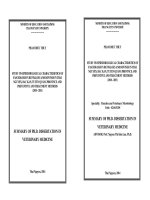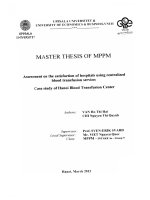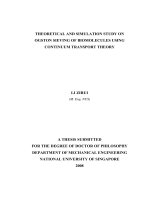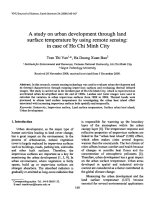STUDY ON URBAN GROWTH OF HANOI USING MULTITEMPORAL AND MULTISENSOR REMOTE SENSING DATA
Bạn đang xem bản rút gọn của tài liệu. Xem và tải ngay bản đầy đủ của tài liệu tại đây (454.6 KB, 5 trang )
STUDY ON URBAN GROWTH OF HANOI USING MULTITEMPORAL
AND MULTISENSOR REMOTE SENSING DATA
Nguyen Dinh Duong, Le Kim Thoa, Nguyen Thanh Hoan, Tran Anh Tuan, Ho Le Thu
Department of Environmental Information Study and Analysis
Institute of Geography, Hanoi, Vietnam
Fax: 84-4-8361192, Phone: 84-4-7562417, Email:
ABSTRACT
Hanoi is the capital of Vietnam with population of about 2.5 millions. Recent development in the
economy has obvious impacst on growth of Hanoi City. This change can be monitored using multitemporal
remote sensing images. In this study, the authors use multitemporal remote sensing images from 1975 to 2001 to
monitor the growth of Hanoi city areas. The remote sensing data set is composed of LANDSAT MSS, TM, SPOT
and TERRA ASTER images. These images have been geo-referenced and resampled to 15 m resolution. Both
visual interpretation and Maximum Likelihood classification methods have been applied. Finally, a map of
urban growth of Hanoi was established. By combination of socio-economic and other local geographical
information with results derived from remote sensing data analysis, some discussions on urban growth of Hanoi
from 1975 to 2001 were presented. The study also aims to demonstrate the usefulness of mutitemporal remote
sensing data usage for monitoring dynamic phenomena such as urban growth.
1.
Introduction
Since 1975 Vietnam has experienced several economic development phases with
different stamps of success. One of the most important milestones in development that
influenced in a great scale on the growth of Hanoi City is transition from a centrally planned
to market-oriented economy. The doi moi (reform) economic liberalization policies embarked
in the mid-1980s have spurred unprecedented rates of economic growth and industrial
development. One of the most evident effects of economic growth is the urbanization of
agricultural land and the rural to urban migration of laborers. The rate of urban expansion is
expected to escalate as the reforms continue and populations flood the cities in search of new
economic opportunities. Together with Haiphong and Quang Ninh, Hanoi is at the center of
the Red River Delta, one of the most important development triangles in Vietnam. The
region sits on a large floodplain and patchwork of rice paddies, transected by numerous
irrigation canals. The continuous urban expansion will have significant impacts on
agriculture, drainage patterns, the occurrence of urban flooding, and sustainable land use. In
this study, we use data from four sensors MSS, TM, SPOT HRV and ASTER, to examine
urban growth dynamics in the Hanoi area between 1975 and 2001
2.
Methods
The satellite data is composed of 6 images (table 1). The images were registered to the
2001 ASTER scenes with spatial resolution resampled to15 m. (On figure 1 is shown Hanoi
City from 1975 to 2001) Due to different spatial resolution, the 1975 image appears as the
coarsest. The 1975 year is just after the Vietnam War. Most constructions have been
destroyed. There is not seen clear typical pattern for city on this image. It is easy to
understand. Most urban areas (built up areas) were under tree coverage. One can find out
hardly some infrastructures such as roads, old city or big constructions like railway station,
factories etc. Since then the city has been rapidly developed. In 1984 the city could be very
well interpreted by both colour shades and urban structure. From 1986 to 2001, the city has
been continuously expanded. The changes could be qualitatively recognized by visual
International Symposium on Geoinformatics for Spatial Infrastructure Development in Earth and Allied Sciences 2002
interpretation, however, for quantitative evaluation we have selected only images of the last
three dates 10/21/1992, 12/20/1999 and 11/16/2001.
Table 1. Characteristics of imagery used in the study
Scene
Acquisition Date
MSS
12/29/75
05/08/84
10/21/86
SPOT
HRV
TM
10/21//92
12/20/99
ASTER
11/16/01
Bands Used (μm)
0.5 - 0.6
0.6 - 0.7
0.7 - 0.8
0.5 - 0.6
0.6 – 0.7
0.8 – 0.9
Resolution (m)
80
20
0.52 - 0.60
0.63 - 0.69
0.76 - 0.90
30
0.52 - 0.60
0.63 - 0.69
0.76 - 0.86
15
Figure 1. False colour composite of Hannoi city in 1975 (top left), 1984 (top right),
1986 (middle left), 1992 (middle right), 1999 (bottom left) and 2001 (bottom right)
Study on urban growth of Hanoi using multitemporal and multisensor remote sensing data
These three images were acquired in almost the same season so we can expect that
seasonal change could be neglected. At first the ASTER image of 2001 was classified by the
Maximum likelihood method to define the largest extension of the city. The urban extension
was used as a mask image to limit the framework for change analysis. For simplification, we
took study area only on the west site of the Red river delta.
Figure 2. Urban area extraction by MLC. Hanoi in 1992 (left), 1999 (middle) and 2001
(right)
The classified images has 5 classes: old housing area, new construction, bare land,
vegetation and water body. These classes were defined using GPS photo database and field
work.
Figure 3. Training sample selection using GPS photo database
A graph of change analysis of Hanoi from 1992 is shown on figure 3. For this purpose
we merged the old with the new construction class so that the number of classes are only
four. The urban development has result on the increase of built up area and the decrease of
vegetation cover, agriculture land, bare land and water body. The built up area has been
expanded from 3248 ha (1992) to 4882 ha (1999) and 5467 ha (2001). It is about 50% of the
city has been enlarged in period from 1992 to 1999 and 68% from 1992 to 2001. This
development has led to the loss of other resources such as agriculture land, vegetation cover
and water bodies. Of course, the loss of these resources is inevitable in urbanization,
International Symposium on Geoinformatics for Spatial Infrastructure Development in Earth and Allied Sciences 2002
however, keeping rational proportion of them is a key factor to ensure sustainability of the
urban environment.
Spatial comparison of Hanoi in 1992 and 2001 is shown on figure 4. The inner polygon
defines Hanoi City in 1992 and the outer boundary is the latest expansion of Hanoi City in
2001. These boundaries have been visually interpreted by TM images in respective years.
The
arrows
mark
6000
1992
prevalent
directions
of
the
Figure 3
city growth. After almost
1999
5000
ten years of development
2001
the
city
has
been
4000
expanded to the west and
the south sites. The east
3000
site is blocked by the Red
river
therefore
the
2000
expansion could not take
place much there. The
1000
development of Hanoi is
tightly linked with the
0
development of Vietnam.
1
2
3
4
5
The growth of GDP of
Vietnam from 1991 to
1995 is 12.52% and from
Figure 4
1996 to 2000 is 10.38%.
GDP growth of Hanoi for
the period 1991-2000 is
2-3%, higher than the
country GDP growth. The
change of proportion in
land use detected by
remote sensing data is
reflected
in
some
economic values. For
instance, increase in built
up area is influenced by
housing development on
one hand and also
industrial infrastructure
development. The GDP
growth for industry sector
is estimated for 15% /year
for the past 5 years in
Hanoi while agriculture
GDP has gone down from
5.13% in 1996 to 3.8% in 2000. The urbanization process seems to follow the transportation
network development. Along new roads there have been established spontaneously light
commerce centres which played a leading role in formulation of the new urban area. The
foreign investment has played also a positive role in pushing the development of Hanoi.
Study on urban growth of Hanoi using multitemporal and multisensor remote sensing data
3.
Conclusion
Preliminary results indicate that multi-sensor and multitemporal data are useful for
assessing urban growth dynamics. Thus far, we have only applied a simple classification
algorithm to a limited set of spectral bands. Our next step is to evaluate the utility of
additional bands and other change detection approaches for our study area. The inclusion of
SAR data could improve the quality of classification by bringing more information on urban
structure that the conventional optical data cannot provide. The Hanoi area is of historical,
agricultural, and cultural importance. As such, monitoring urban growth in the region is
important for understanding the direct and indirect effects of policy reforms on sustainable
land use.
REFERENCE
Nguyen Dinh Duong et al. 2002. Monitoring of Hanoi Environment using Multitemporal Remote
Sensing Data. Institute of Geography. Hanoi
Karen C. Seto, Nguyen Dinh Duong, 2002. Using a multi-sensor approach to monitoring urban
growth in greater Hanoi, 1975-2001.Proceedings of the International Symposium “Remote sensing of
Urban Area”, Istanbul, Turkey
International Symposium on Geoinformatics for Spatial Infrastructure Development in Earth and Allied Sciences 2002









